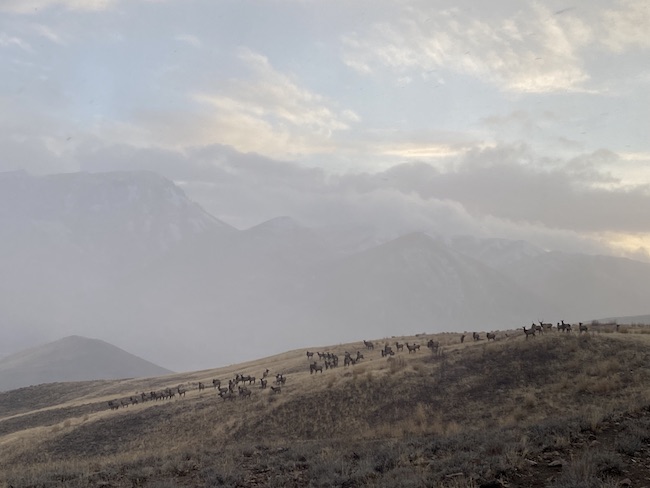BY HARRY WEEKES
On Saturday afternoon, November 2, I was lying on my couch reading an article. It was 4:15 p.m. when my phone rang.
“Do you want to go elk hunting?”
“Now?”
In 53 years of living in the Wood River Valley, I had never been elk hunting. In fact, I had never been so much as asked.
An hour later, standing on a ridge, getting my breathing under control, we were going over the game plan. My role was to cut east, drop down through an open meadow, pick up an old road I had seen for the first time 30 minutes ago in a pair of binoculars from the other side of the highway, and then swing around in a huge arc that was intended to bring me out below a herd of elk. From there, I was supposed to stand—a visual deterrent to any downhill flight.
My companions set off on their designated routes, and soon enough I was going through a series of mental gymnastics, one part of which was orienting myself to exactly where I was in the world, even though I knew vaguely where I was. In a little less than an hour, I had made half a circle around the elk herd and was now charged with reading a landscape on foot that I had only seen from afar. To this, I had the adrenaline of quick hiking coupled with the idea that came out bluntly as, “What if we actually kill an elk?”
This set me to considering the mind of the elk, and wondering, in the herd, which one was most likely not to make it.
All of this added up to a kind of hyper-attentiveness, the so-called “presence” that everyone talks so much about. “Be present in the world.” Cruising through a thin layer of snow, over unfamiliar terrain, all with the idea that you are intending to kill something creates some kind of predator mindset. There is attunement, to everything. The crinkling leaves and grass. The light cutting out of clouds portending snow. The distant call of a magpie. Emotions that were a mix of fear, preemptive sadness, determination, and a kind of wonder scurried around like restless mice.
No spoiler alert here. As one might imagine when a total novice sets out on a hunt, the 100-plus animals with their 200-plus eyes and 100 noses picked me up before I picked them up. For my part, I heard a couple of beautiful little elk whistle-chirps—the kind of thing you might expect from a marmot or ground squirrel. Heads were raised, and then, in a casual group trot, the entire herd loped over a nearby rolling ridge and headed from the high country to the river.
We humans were left with the hike out. A beautiful return across Idaho’s sage and scrub. Venus emerged in the sky to the southwest. The sun disappeared. And in a light made purple and blue by snow, we dropped down a small ravine and headed back to the car, all the while talking about elk, and about hunting, and about this portion of the planet we found ourselves in.
Of the snippets that stuck with me were two from the son of the man who called me responding to his dad saying how there is always real sadness in successfully killing such a beautiful animal. “We say that if you don’t cry every time you kill an animal, maybe you should stop killing animals.”
This was followed by me asking if people eat elk heart and if it’s any good. He looked up, cocked his head, and replied, “It’s a different chew.”
I returned from my “armed hike” at 7:15 p.m. I am tempted to say “empty-handed,” but that turns out not to be true at all.
Harry Weekes is the founder and head of school at The Sage School in Hailey. This is his 53rd year in the Wood River Valley, where he lives with Hilary and two mini-Dachshunds. The baby members of their flock have now become adults—Georgia and Simon are fledging in North Carolina, and Penelope is fledging in Vermont.



